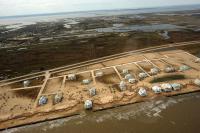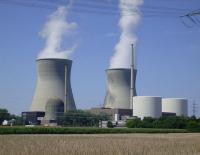-
Structural, regulatory, and human errors contributed to Washington bridge collapse
When an important bridge collapsed on Interstate 5 near Mount Vernon, Washington, in 2013, questions were raised about how such a catastrophic failure could occur. A new analysis outlines the many factors that led to the collapse, as well as steps that transportation departments can take to prevent such accidents on other bridges of similar design.
-
-
Chicago becomes first city to launch Array of Things, an innovative urban sensing project
This week in Chicago, the Array of Things team begins the first phase of the groundbreaking urban sensing project, installing the first of an eventual 500 nodes on city streets. By measuring data on air quality, climate, traffic, and other urban features, these pilot nodes kick off an innovative partnership among different organizations aiming better to understand, serve, and improve cities.
-
-
Assessing climate change vulnerability in urban America
Impacts of climate change – rising sea levels, heat waves, rising rates of diseases caused by ticks, fleas, and mosquitoes, and many more — will affect cities across the country. One of the first efforts systematically to assess how cities are preparing for climate change shows that city planners have yet fully to assess their vulnerability to climate change, leaving serious risks unaddressed. Most city planners have yet to prepare for climate-related risks and the consequences.
-
-
New cooling method for large data centers to save millions of gallons of water
In different parts of the country, people discuss gray-water recycling and rainwater capture to minimize the millions of gallons of groundwater required to cool large data centers. But the simple answer in many climates is to use liquid refrigerant. A cooling system – if installed next year at Sandia National Laboratories computing center – is expected to save 4 million to 5 million gallons annually in New Mexico, and hundreds of millions of gallons nationally if the method is widely adopted.
-
-
Water pollution across three continents poses health risks to hundreds of millions
Water pollution has risen across three continents, placing hundreds of millions of people at risk of contracting life-threatening diseases like cholera and typhoid. Pathogen and organic pollution rise in more than 50 percent of river stretches in Africa, Asia, and Latin America. Asia hit hardest by rise in severe pathogen pollution, with up to a half of all river stretches affected. Up to 323 million people on three continents at risk of infection from diseases caused by pathogens in water.
-
-
Underground radar locates post-Katrina damage

An innovative underground radar technology is helping a city of in south Louisiana to identify and document underground infrastructure damage that had gone undetected in the months and years following Hurricane Katrina. This radar technology is a pipe-penetrating scanning system based on a new technology called ultra-wide band (UWB) pulsed radar. UWB allows for the inspection of buried pipelines, tunnels, and culverts to detect fractures, quantify corrosion, and determine the presence of voids in the surrounding soil often caused by storm water leaks and flooding.
-
-
Italy’s deadly earthquake is the latest in a history of destruction
The Appenines region of central Italy has been struck by a deadly earthquake, with a magnitude of 6.2. This earthquake is no surprise. Italy is prone to earthquakes; it sits above the boundary of the African and European plates. The Appenines region’s earthquake history can be traced back over seven centuries. Within the region, there is excellent and continuously improving scientific information about the hazard. But the knowledge of the hazard has not always translated well into measures that directly reduce economic loss and fatalities in earthquakes. Numerous vulnerable buildings remain, and the recovery process is commonly plagued by long disruptions and inadequate government funding to recover rapidly. Both the 2009 L’Aquila earthquake and this most recent quake highlight just how important it is to translate hazard assessments into improving the resilience of infrastructure to strong shaking. The focus should remain on linking science, engineering and policy, this is often the biggest challenge globally.
-
-
Large-scale metamaterials could earthquake-proof buildings in tremor-prone regions
Metamaterials – artificial structures that exhibit extraordinary vibrational properties – could come to the rescue of regions threatened by earthquakes, according to new research. The study, performed by researchers in Europe and involving detailed computer simulations, shows that large-scale metamaterials can attenuate the energy and amplitude of harmful low-frequency vibrations associated with seismic shocks.
-
-
Can we get better at predicting earthquakes?
In the wake of the deadly earthquake, measuring 6.2, which rocked central Italy in the early hours of 24 August, questions again have been raised about whether earthquakes can be predicted. Fortunately, all earthquakes do not lead to disasters and, therefore, understanding where and why disasters are produced is the first goal of earthquake seismology. The first issue is thus one of semantics and objectives. Is the goal to predict an earthquake occurrence, predict ground motion due to an earthquake, or predict a disaster? In our efforts to better predict earthquakes, we have to be precise about the timescale: is it a prediction that an earthquake is imminent – that is, within seconds, hours, or even days before the shaking? Or that it is likely to happen within years or tens of years? There is hope that one day we could detect and monitor extremely slight changes in the rocks that would precede earthquakes – but this is still a long way from “prediction” of precisely when and where a disaster will occur. For now, knowing earthquakes is one way to live with them, to be prepared, to know the vulnerability of our communities and to adopt sound policies for earthquake-safe environments.
-
-
Nuclear forensics summer program trains students for a future in nuclear security
A sure sign of summer is the return of interns to the Lawrence Livermore campus. Students interact with premier researchers and access equipment and facilities not available anywhere else, while scientists lay groundwork for advancing their fields. LLNL runs an eight-week summer internship for students interested in nuclear science and its range of specialties — nuclear forensics, environmental radiochemistry, nuclear physics, and beyond. Together, these disciplines support the laboratory’s nuclear security mission through analysis of nuclear processes and properties.
-
-
Combining high performance computing, public policy analysis for better water resource management
With growing demand and a changing climate, the Colorado River Basin is under significant stress. The river supplies water to thirty million people in seven states, supports billions of dollars in economic activity each year, and irrigates 15 percent of all U.S. crops. It also provides water to twenty-two Native American tribes, four national recreation areas, and eleven national parks. Researchers have joined forces to combine high-performance computing with innovative public policy analysis to improve planning for particularly complex issues such as such as water resource management.
-
-
Wider temperature tolerance is based on ion-pair-coordinated polymers
A new class of fuel cells based on a newly discovered polymer-based material could bridge the gap between the operating temperature ranges of two existing types of polymer fuel cells, a breakthrough with the potential to accelerate the commercialization of low-cost fuel cells for automotive and stationary applications.
-
-
Rising seas threaten 1.9 million U.S. homes with current value of $882 billion

Typically when we talk about “underwater” homes, we are referring to negative equity. But there is a more literal way a home can be underwater: Rising sea levels, and the flooding likely to come with them, could inundate millions of U.S. homes worth hundreds of billions of dollars. If sea levels rise as much as climate scientists predict by the year 2100, almost 300 U.S. cities would lose at least half their homes, and 36 U.S. cities would be completely lost. The total combined current value of all homes at risk of being underwater with a 6-feet rise in sea levels is $882 billion.
-
-
The lesson from the demise of the Maya civilization: Water shortage can destroy cultures
Within a short period of time, the advanced Maya civilization in Central America went from flourishing to collapsing — the population dwindling rapidly and monumental stone structures, like the ones built at Yucatán, were no longer being constructed. Mathematical models analyzing the interplay between society and hydrological effects have found the explanation: the irrigation technology that served the Mayans well during periods of drought may have actually made their society more vulnerable to major catastrophes. These models provide insights into ancient cultures – as well as into our own future.
-
-
Pro-nuclear countries slowest to make progress on climate targets

A strong national commitment to nuclear energy goes hand in hand with weak performance on climate change targets, researchers found. A new study of European countries shows that the most progress toward reducing carbon emissions and increasing renewable energy sources has been made by nations without nuclear energy or with plans to reduce it. Conversely, pro-nuclear countries have been slower to implement wind, solar, and hydropower technologies and to tackle emissions.
-
- All
- Regional
- Water
- Biometrics
- Borders/Immig
- Business
- Cybersecurity
- Detection
- Disasters
- Government
- Infrastructure
- International
- Public health
- Public Safety
- Communication interoperabillity
- Emergency services
- Emergency medical services
- Fire
- First response
- IEDs
- Law Enforcement
- Law Enforcement Technology
- Military technology
- Nonlethal weapons
- Nuclear weapons
- Personal protection equipment
- Police
- Notification /alert systems
- Situational awareness
- Weapons systems
- Sci-Tech
- Sector Reports
- Surveillance
- Transportation
Advertising & Marketing: advertise@newswirepubs.com
Editorial: editor@newswirepubs.com
General: info@newswirepubs.com
2010-2011 © News Wire Publications, LLC News Wire Publications, LLC
220 Old Country Road | Suite 200 | Mineola | New York | 11501
Permissions and Policies
Editorial: editor@newswirepubs.com
General: info@newswirepubs.com
2010-2011 © News Wire Publications, LLC News Wire Publications, LLC
220 Old Country Road | Suite 200 | Mineola | New York | 11501
Permissions and Policies
